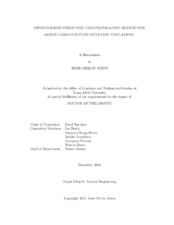| dc.contributor.advisor | Tsvetkov, Pavel | |
| dc.creator | Johns, Jesse Merlin | |
| dc.date.accessioned | 2015-04-28T15:39:38Z | |
| dc.date.available | 2016-12-01T06:36:12Z | |
| dc.date.created | 2014-12 | |
| dc.date.issued | 2014-12-18 | |
| dc.date.submitted | December 2014 | |
| dc.identifier.uri | https://hdl.handle.net/1969.1/154210 | |
| dc.description.abstract | The Monte Carlo method for solving reactor physics problems is one of the most robust numerical techniques for analyzing a wide variety of systems in the realm of reactor engineering. Monte Carlo simulations sample on fundamental physical processes without making significant numerical approximation while using the best available data describing nuclear interactions with matter. These calculations are often used as benchmarks for faster, lower fidelity deterministic codes. As computing systems become more powerful, the Monte Carlo method has become quite popular and coupling to other methods/codes is almost ubiquitous. A typical coupled calculation might include the assessment of the time dependent behavior of reactor materials resulting from irradiation. The Monte Carlo neutron transport calculation is already a significant computational task; the multiscale depletion simulation significantly increases the computational requirements. This type of coupling is often performed with an operator splitting technique; the neutron transport solution feeding reaction rates to the deterministic depletion simulation. It is shown by manual temporal refinement studies that it is imperative to resolve the change in the neutron flux and cross-sections in time to minimize errors resulting from the temporal discretization. Often in practive, the temporal convergence is checked by running additional simulations with increased time resolution; an often wasteful task if further refinement is not necessary. By assessing driving characteristics of coupled neutron transport and depletion calculations, a new method is developed using a physics-based approximation to predictively adapt the time step, with minimal computational cost, to ensure a close-to-converged coupled simulation. This method develops a temporal grid such that a priori knowledge of time steps is not required and that further refinement studies become unnecessary. This method was tested with various permutations of light water reactor cases with satisfactory results. | en |
| dc.format.mimetype | application/pdf | |
| dc.language.iso | en | |
| dc.subject | Monte Carlo | en |
| dc.subject | neutron transport | en |
| dc.subject | nuclear depletion | en |
| dc.subject | temporal convergence | en |
| dc.title | Physics-based Predictive Time Propagation Method for Monte Carlo Coupled Depletion Simulations | en |
| dc.type | Thesis | en |
| thesis.degree.department | Nuclear Engineering | en |
| thesis.degree.discipline | Nuclear Engineering | en |
| thesis.degree.grantor | Texas A & M University | en |
| thesis.degree.name | Doctor of Philosophy | en |
| thesis.degree.level | Doctoral | en |
| dc.contributor.committeeMember | Bragg-Sitton, Shannon | |
| dc.contributor.committeeMember | Braby, Leslie | |
| dc.contributor.committeeMember | Leppanen, Jaakko | |
| dc.contributor.committeeMember | Petrova, Guergana | |
| dc.contributor.committeeMember | Reece, Warren | |
| dc.type.material | text | en |
| dc.date.updated | 2015-04-28T15:39:38Z | |
| local.embargo.terms | 2016-12-01 | |
| local.etdauthor.orcid | 0000-0003-4623-9802 | |


